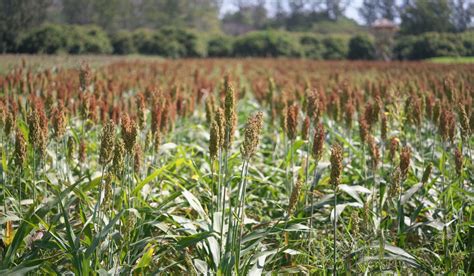How To Grow Japanese Millet
Ronan Farrow
Mar 31, 2025 · 3 min read

Table of Contents
How to Grow Japanese Millet: A Comprehensive Guide
Japanese millet, also known as Echinochloa frumentacea, is a warm-season annual cereal grain that's gaining popularity for its nutritional value and adaptability. This comprehensive guide will walk you through everything you need to know to successfully cultivate this versatile crop, from seed selection to harvesting.
Understanding Japanese Millet
Before diving into the cultivation process, let's understand what makes Japanese millet unique. It's known for its drought tolerance, making it a suitable choice for arid and semi-arid regions. It's also relatively low-maintenance, requiring less fertilization and pest control compared to other grains. Furthermore, Japanese millet is nutritious, providing a good source of carbohydrates, protein, and essential minerals.
Key Characteristics:
- Warm-season crop: Requires warm temperatures for germination and growth.
- Tolerant to drought: Can survive in dry conditions, although optimal yields require adequate moisture.
- Short growing season: Maturity typically ranges from 60 to 100 days.
- Adaptable to various soil types: Prefers well-drained soils, but can tolerate slightly acidic conditions.
Planting Japanese Millet: A Step-by-Step Guide
1. Selecting the Right Seed:
Choose high-quality Japanese millet seeds from a reputable supplier. Look for seeds that are clean, plump, and free from disease. Seed treatment with a fungicide can further protect against fungal diseases.
2. Preparing the Soil:
Proper soil preparation is crucial for optimal growth. Till the soil to a depth of 6-8 inches to improve drainage and aeration. Remove any weeds or debris. A soil test can help determine the necessary soil amendments, like adding compost to improve soil fertility.
3. Sowing the Seeds:
- Planting time: Sow seeds after the last frost when soil temperatures consistently reach 60-70°F (15-21°C).
- Planting method: Direct seeding is the most common method. Broadcast sowing or drilling are both effective. For broadcasting, simply scatter seeds evenly over the prepared soil surface. For drilling, use a seed drill to sow seeds at a consistent depth and spacing.
- Seed depth: Plant seeds at a depth of ½ to 1 inch.
- Spacing: Maintain a spacing of 6-12 inches between plants for optimal growth and yield.
4. Providing Adequate Water:
While drought-tolerant, Japanese millet benefits from consistent watering, especially during germination and early growth stages. Irrigate regularly, but avoid overwatering, which can lead to root rot. Mulching can help retain soil moisture and suppress weeds.
5. Fertilization and Weed Control:
Japanese millet has moderate nutrient requirements. A balanced fertilizer application can enhance growth and yield. Weed control is essential, especially in the early stages of growth. Regular weeding or using a pre-emergent herbicide can help manage weeds effectively.
Harvesting and Post-Harvest Management:
Harvesting:
Harvest when the seeds are mature and the panicles (seed heads) have turned golden brown. This typically occurs 60-100 days after planting, depending on the variety and growing conditions. Harvesting can be done manually or with a combine harvester.
Post-Harvest:
After harvesting, thresh the seeds to separate them from the stalks and chaff. Clean and dry the seeds thoroughly to prevent spoilage. Store seeds in a cool, dry place.
Troubleshooting Common Problems:
- Birds: Protect the crop from birds by using bird netting or scare tactics.
- Insects: Monitor for insect infestations and use appropriate pest control methods if necessary.
- Diseases: Good soil drainage and proper sanitation practices can help prevent diseases.
By following these steps, you can successfully grow a bountiful harvest of nutritious Japanese millet. Remember that success depends on careful planning, proper soil preparation, and consistent monitoring of the crop throughout its growing cycle. Remember to adapt these techniques to your specific climate and soil conditions for optimal results.
Featured Posts
Also read the following articles
| Article Title | Date |
|---|---|
| How To File For Domestic Partnership In Georgia | Mar 31, 2025 |
| How To Get The Brain Out Of A Deer Skull | Mar 31, 2025 |
| How To Get The Swelling Down After Wisdom Teeth Removal | Mar 31, 2025 |
| How To Get Rid Of Algae In My Pond | Mar 31, 2025 |
| How To Get A Apartment With No Job | Mar 31, 2025 |
Latest Posts
-
How To Sell A Car With A Title Loan
Apr 02, 2025
-
How To Sell A Boat In Louisiana
Apr 02, 2025
-
How To See Into The Spiritual Realm
Apr 02, 2025
-
How To See A Psychiatrist Without A Referral
Apr 02, 2025
-
How To Secure Dog In Cargo Area Of Suv
Apr 02, 2025
Thank you for visiting our website which covers about How To Grow Japanese Millet . We hope the information provided has been useful to you. Feel free to contact us if you have any questions or need further assistance. See you next time and don't miss to bookmark.
